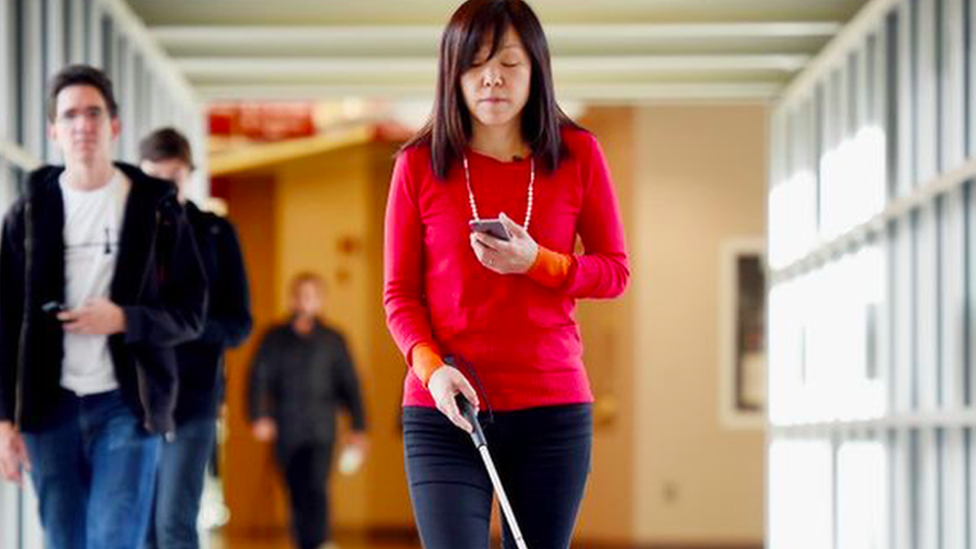INSUBCONTINENT EXCLUSIVE:
Image copyrightIBMImage caption
Chieko Asakawa received Japan's Medal of Honour for her contribution to accessibility
research
An accident in a swimming pool left Chieko Asakawa blind at the age of 14
For the past three decades she's worked to create technology - now with a big focus on artificial intelligence (AI) - to transform life for
the visually impaired."When I started out there was no assistive technology," Japanese-born Dr Asakawa says."I couldn't read any information
I couldn't go anywhere by myself." Those "painful experiences" set her on a path of learning that began with a computer science course for
blind people, and a job at IBM soon followed
She started her pioneering work on accessibility at the firm, while also earning her doctorate
Dr Asakawa is behind early digital Braille innovations and created the world's first practical web-to-speech browser
Those browsers are commonplace these days, but 20 years ago, she gave blind internet users in Japan access to more information than they'd
Image copyrightGetty ImagesImage caption
Braille and voice control are still key technologies for blind people
Now she and other technologists are looking to use AI to create tools for visually impaired people
Micro mappingFor example, Dr Asakawa has developed NavCog, a voice-controlled smartphone app that helps blind people navigate complicated
Low-energy Bluetooth beacons are installed roughly every 10m (33ft) to create an indoor map
Sampling data is collected from those beacons to build "fingerprints" of a specific location
"We detect user position by comparing the users' current fingerprint to the server's fingerprint model," she says
Image copyrightGetty ImagesImage caption
Could navigation apps mean blind people have to rely on canes less
Collecting large amounts of data creates a more detailed map than is available in an application like Google Maps, which doesn't work for
indoor locations and cannot provide the level of detail blind and visually impaired people need, she says."It can be very helpful, but it
cannot navigate us exactly," says Dr Asakawa, who's now an IBM Fellow, a prestigious group that has produced five Nobel prize winners.NavCog
is currently in a pilot stage, available in several sites in the US and one in Tokyo, and IBM says it is close to making the app available
to the public.'It gave me more control'Pittsburgh residents Christine Hunsinger, 70, and her husband Douglas Hunsinger, 65, both blind,
trialled NavCog at a hotel in their city during a conference for blind people
"I felt more like I was in control of my own situation," says Mrs Hunsinger, now retired after 40 years as a government bureaucrat
She uses other apps to help her get around, and says while she needed to use her white cane alongside NavCog, it did give her more freedom
to move around in unfamiliar areas
Image copyrightIBMImage caption
Dr Asakawa says memories of colour help with her work on object recognition and NavCog
Mr Hunsinger agrees, saying the app "took all the guesswork out" of finding places indoors
"It was really liberating to travel independently on my own." A lightweight 'suitcase robot'Dr Asakawa's next big challenge is the "AI
suitcase" - a lightweight navigational robot
It steers a blind person through the complex terrain of an airport, providing directions as well as useful information on flight delays and
gate changes, for example
The suitcase has a motor embedded so it can move autonomously, an image-recognition camera to detect surroundings, and Lidar - Light
Detection And Ranging - for measuring distances to objects
Image copyrightGetty ImagesImage caption
Lidar is more associated with driverless cars than smart suitcases
When stairs need to be climbed, the suitcase tells the user to pick it up
"If we work together with the robot it could be lighter, smaller and lower cost," Dr Asakawa says.The current prototype is "pretty heavy",
IBM is pushing to make the next version lighter and hopes it will ultimately be able to contain at least a laptop computer
It aims to pilot the project in Tokyo in 2020
"I want to really enjoy travelling alone
That's why I want to focus on the AI suitcase even if it is going to take a long time."IBM showed me a video of the prototype, but as it's
not ready for release yet the firm was reluctant to release images at this stage.AI for 'social good' Despite its ambitions, IBM lags behind
Microsoft and Google in what it currently offers the visually impaired
For example, Seeing AI - a talking camera app - is a central part of its accessibility work
Image copyrightMicrosoftImage caption
Microsoft's Saqib Shaikh demonstrates the firm's text-to-speech smartphone app
And later this year Google reportedly plans to launch its Lookout app, initially for the Pixel, that will narrate and guide
visually impaired people around specific objects
"People with disabilities have been overlooked when it comes to technology development as a whole," says Nick McQuire, head of enterprise
and AI research at CCS Insight.But he says that's been changing in the past year, as big tech firms push hard to invest in AI applications
that "improve social wellbeing".He expects more to come in this space, including from Amazon, which has sizeable investments in AI
More Technology of Business"But it's really Microsoft and Google in the last 12 months that have made the big focus in this area," he says
Mr McQuire says the focus on social good and disability is linked to "trying to showcase the benefits [of AI] in light of a lot of negative
sentiment" around AI replacing human jobs and even taking over completely.But AI in the disability space is far from perfect
A lot of the investment right now is about "proving the accuracy and speed of the applications" around vision, he says
Dr Asakawa concludes simply: "I've been tackling the difficulties I found when I became blind
I hope these difficulties can be solved." Follow Technology of Business editor Matthew Wall on Twitter and Facebook

